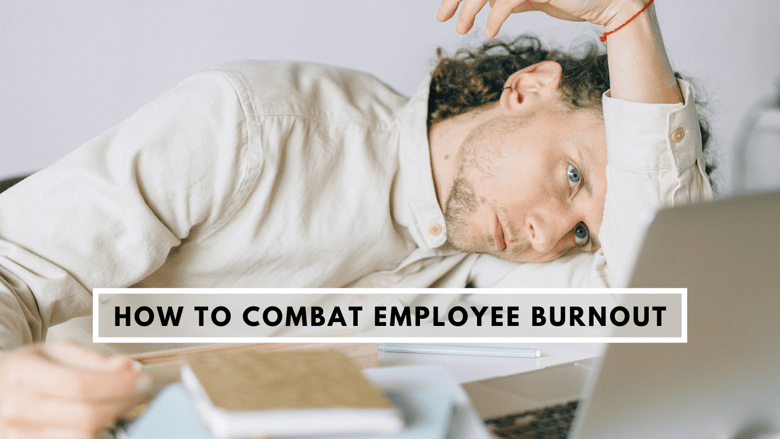While work-related stress isn't new, employee burnout resulting from chronic stress is on the rise. In fact, the World Health Organization declared burnout to be an occupational phenomenon in 2019 due to its increased prevalence in the workplace. Heavy workloads, increased pressure in the workplace, and tight deadlines are all common contributors to employee burnout, and they are amongst the most commonly cited reasons why employees have chosen to quit their jobs during the great resignation. Unfortunately, employee burnout can have wider-reaching consequences for a business than causing high turnover rates.According to the American Institute of Stress, job stress costs U.S. companies over $300 billion annually due to accidents, absenteeism, and diminished productivity in addition to other factors resulting from employee burnout. This makes it important that business owners, CEOs, HR teams, and managers know the causes and signs of employee burnout, as well as the steps that they can take to reduce burnout, as being proactive, can help to reduce the costly effects that burnout can have on your company. Keep reading for more information on what causes burnout and the steps that you can take to combat its effects in the workplace.

Excited to help your team?↠ Talk to a ScalePEO Specialist now!
What Causes Burnout?
Employee burnout is usually caused by the fast-paced environment of the modern workplace, which can leave employees feeling overwhelmed. While multiple factors can contribute to an employee experiencing burnout, some of the most common causes include:
An Unmanageable Workload
-
Long Hours
-
Unfair Treatment at Work
-
Unreasonable Deadlines
-
And a Lack of Support From Management
Individually, each of these factors can lead to chronic stress; but in combination, they can make a workplace unbearable, causing burnout and high turnover rates.
What Are The Most Common Signs of Burnout?
Considering the risks associated with having high rates of employee burnout in the workplace, it is important that management is aware of the signs and symptoms of burnout so that they can take steps to reverse it. Common signs of employee burnout include employees who:
-
Exhibit Signs of Chronic Exhaustion
-
Seem Distant or Cynical About Their Job/Workplace
-
Have Decreased Productivity
-
Increased Absenteeism
Employees exhibiting these symptoms are likely struggling with burnout and are struggling to survive in the workplace. These employees will have decreased professional efficiency and will be much more likely to look for a new job placement, which is why it is critical that management takes steps to combat burnout if they notice these symptoms in their workforce.
-png.png) What Steps Can Be Taken to Prevent/Reverse Burnout?
What Steps Can Be Taken to Prevent/Reverse Burnout?
Fortunately, while burnout is costly, it is preventable, and it can be reversed if discovered soon enough by management. Having the right strategies in place can help ensure your employees are happy with their workload and workplace environment, significantly reducing rates of burnout and employee turnover. Here is a look at just a few strategies that you can implement in the workplace to reduce burnout.
Promote a Healthy Work/Life Balance
One of the best ways to prevent employee burnout is to promote a healthy work/life balance. The fact is that poor work/life balance and not having a life outside of work is one of the most common reasons employees give for leaving a job. Management then has a responsibility to ensure employees have time for exercise, family, and self-care. Work/life balance can be encouraged by offering flexible schedules to accommodate different work styles, or by shutting the office early before holidays to demonstrate the importance of spending time with loved ones. Many companies even encourage employees to remain "unplugged" when they are off the clock so that they are not tempted to focus on work during their free time. Such initiatives can go a long way in not only encouraging a work/life balance, but also in demonstrating management's commitment to employee wellbeing.
Create Fair Workloads
Another common cause of burnout is employees feeling overworked or under intense pressure from deadlines. It is then imperative that managers monitor employee workloads and schedules in order to ensure that employees aren't being overexerted. While workloads may spike occasionally, employees can't maintain heavy workloads and demanding schedules for long periods of time, which is why it is important that employees are provided with recovery time after periods of intense work. Managers also need to ensure that they distribute work fairly and that they keep an eye out for employees who are being overworked and redistribute assignments as necessary. If you notice that a certain department has high turnover rates, this can be an indicator of a problem with workload or schedule.
Encourage Employees to Use Vacation Time
Burnout is also often caused by employees going for extended periods without time off from work. The fact is that it is not uncommon for employees to not use all of their given vacation time before the end of the year, however, this often isn't due to a lack of desire to take time off. The most common reasons people cite for not using their vacation time include having a heavy workload, a lack of coverage when they are out of the office, and being afraid that they will upset management if they take a long vacation. However, it is critical that managers create an environment where vacations aren't just tolerated but are encouraged. The fact is that when employees feel like they aren't able to use their vacation time, they are much more likely to experience burnout, leading to reduced productivity and high turnover rates.
Train Managers
Proper training for management is one of the most important steps a company can take to proactively prevent employee burnout. The fact is that managers are responsible for employee experiences, and they play a critical role in ensuring employees stay engaged and motivated to do their best. Managers are the ones who control employee workload and create the culture within their department, and it is up to them to ensure that employees feel valued and do not experience chronic stress or burnout. Proper training from HR can then go a long way in ensuring managers have the proper tools to spot and prevent burnout within their departments, which can go a long way in reducing costly turnover rates.
Knowing the causes of employee burnout and the steps that you can take to prevent burnout can go a long way in improving the culture and morale within your company as well as in reducing turnover rates. Feel free to contact us to learn more about steps that you can take to combat employee burnout at your company.


-png.png)

